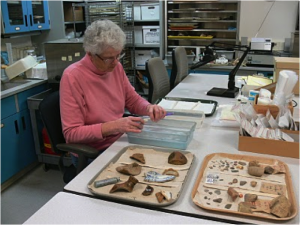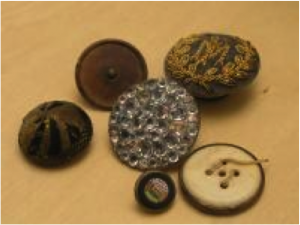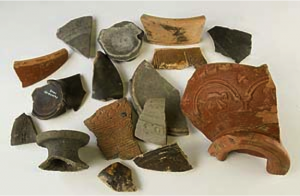What comes to mind when you think of archaeology? Do you think of the archaeologist who seeks to learn and preserve the past—the archaeologist who sees a broken glass bottle as treasure? Or do you think of the stereotypical archaeologist who digs up mummies and gold? Regardless of which you picture, you think of the archaeologist as working in the field. Rarely do people picture archaeologists in the lab. What does archaeological lab work really entail? How do archeologists find out information about artifacts? I didn’t know what to expect when I went to my lab work, but I was excited to find out.
When I walked into the lab, there was a long table with two boxes full of plastic bags in the center of the room. I sat down and took a peek at the contents of the boxes—from my quick glance, I saw bags full of pottery, bones, and broken glass. My professor walked in and told us that our task was to sort and organize artifacts from a site in Annapolis, Maryland. And with those instructions, my first archaeological lab work began.
The first bag I grabbed contained many different buttons. There appeared to be different types of buttons—some were white and shiny while others were rusty and black. After separating the buttons into categories based on appearance, we determined that there were six plastic buttons, eight glass buttons, two metal buttons, and two oyster-shell buttons. One of the metal buttons had an emblem on it—and with some research, my professor determined it was military button from the Civil War period. Thus, we could conclude that soldiers must have been in the area—but for what? Were soldiers just passing through the local tavern? Or was a solider returning home after battle? This question is left hanging until more research is done.
My group sorted about twenty bags of artifacts—some containing rusty nails others with pieces of glass. My two favorite artifacts were the broken pottery pieces and the animal bones. By looking at the material and color, we could sort the pottery pieces into types and estimate the time period it came from. Some of the pottery was white-ware while other pieces were buckley ware and others earthenware. Similarly, by closely looking at the bones, I sorted them into bird, reptile, mammal, and fish bones (with help of course). By working with my professor, I was able to see difference in each type of animal bone. For example, mammal bones are thick and dense while bird bones are mostly thin and hollow. Understanding these differences helped bring me one step closer to being an animal bone expert!
While fieldwork might provide an exciting adventure, it is in the lab that artifacts’ secrets are uncovered. In the lab, archaeologists can learn about the change of artifacts over time, their importance, and their relevance in history. Simply stated, it is in the lab where the past is revealed.
References:
Ashmore, Wendy and Robert J. Sharer. Discovering Our Past: A Brief Introduction to Archaeology. New York: McGraw- Hill, 2012. Print.
Image 1: http://twipa.blogspot.com/2011_01_01_archive.html
Image 2: http://www.antiquebuttons.nl/index_en.php?p0=history_of_buttons
Image 3: http://www.culture24.org.uk/history-and-heritage/archaeology/art72020




It’s interesting that you mention the button of a soldier, since military items are often objects of great interest in archaeology. Military buttons are particularly useful artifacts when it comes to dating, as they are specific to certain uniforms (which, if recent enough, are easily dated) and tend to be very well documented in military history texts. Even ordinary buttons can give insight into the daily lives of civilians, though their context can sometimes be harder to identify. As Sarah Marcel notes, most clothes “do not survive in the archaeological record.” However, she notes, buttons can be particularly revelatory because they “represent…surviving descriptions of daily wear.” Her study of buttons, originally an Honors thesis at the University of Tennessee, attempts to create a typology of buttons using her archaeological research. She does note that the archaeological record can be biased when it comes to buttons; wood, bone, shell, and ceramic buttons preserve the best in the archaeological record, as do metal buttons and the metal underlays of cloth buttons. Marcel works with buttons from the eastern United States, noting trends in the practical and decorative use of buttons in both men and women’s clothing in the 19th century. The construction and materials of buttons, she argues, can reveal anything from the relatively high status of a particular slave to the beginning of the decorative beading trend in women’s clothing.
If you’re interested in her research, read her article here: http://trace.tennessee.edu/cgi/viewcontent.cgi?article=1042&context=utk_chanhonoproj&sei-redir=1&referer=http%3A%2F%2Fwww.google.com%2Furl%3Fsa%3Dt%26rct%3Dj%26q%3Dbutton%2520typology%26source%3Dweb%26cd%3D1%26ved%3D0CCsQFjAA%26url%3Dhttp%253A%252F%252Ftrace.tennessee.edu%252Fcgi%252Fviewcontent.cgi%253Farticle%253D1042%2526context%253Dutk_chanhonoproj%26ei%3D0kKEUsKlH-2-sQSVnoDQBw%26usg%3DAFQjCNH07JsFIV2fhJvQcIreluQVnAojMg%26bvm%3Dbv.56343320%2Cd.cWc#search=%22button%20typology%22